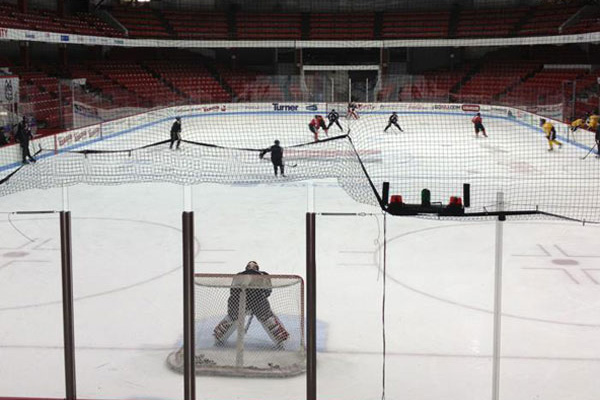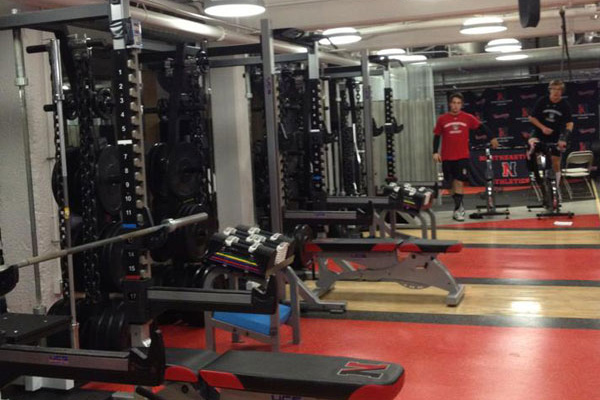Work Out Like: A College Hockey Player
 The team takes the ice for practice at Northeastern’s Matthews Arena. Photos by Jamie Ducharme
The team takes the ice for practice at Northeastern’s Matthews Arena. Photos by Jamie Ducharme
Syracuse can have basketball and Alabama can have their football program, because here in Boston, colleges are all about hockey. We caught up with Dan Boothby, director of strength and conditioning for the Northeastern University men’s hockey team, to find out just what it takes to make it on the ice. So lace up your skates, pull out your weights, and get ready to train like a college hockey player.
Hit the gym, hard
Northeastern hockey players can squat twice their body weight, hang clean (a weightlifting term) one and a half times their body weight, and complete twenty pull ups, says Boothby. The team also has to do rigorous speed and wind testing. “We do hold everyone to a pretty good standard of fitness,” he says. “We evaluate pretty extensively.”
Make it work for you: Take a page from Northeastern’s book and mix up your schedule. Boothby says that every day of the week has a different type of muscle training. Mondays are reserved for low weight but high repetition work to recover from the weekend’s games, Tuesdays are for high intensity but low volume work, and Wednesdays are for sport-specific plyometrics. If you’re not sure where to start for your own workout, check out these weight training tips from Men’s Fitness. And ladies, don’t forget it’s important for you to hit the weights too.
Be consistent
On an average in-season training week, the team has one day off with optional exercises to do on that day. Each practice includes about an hour each of strength and conditioning and ice time. “At this level, at this league, they need to understand what they need to do on a day-to-day basis,” Boothby says. “Twenty-four hours a day, seven days a week.”
Make it work for you: Set a schedule that works for you, and find a way to hold yourself accountable, whether by bringing a friend or making up some kind of reward system.
Develop endurance
“You need to have skills, but you also need to have conditioning,” Boothby says of his players, who spend time developing breathing recovery techniques to help maintain energy. “I think that you need to be able to physically perform, you need to be able to maintain intensity.” Plus, Boothby says, it’s important to adjust workouts over time so as to avoid injury and progress breakdown. “The demands of skating are, biomechanically, challenging,” he says. “We want to identify the changes we’re seeing in those athletes, correct those, and adjust those and then individualize those.”
Make it work for you: Developing conditioning and cutting down on recovery time through cardiovascular exercise is key to achieving better fitness. “We will use different training intensities, durations, and recovery times to prescribe training prescriptions,” Boothby says, explaining that while his players do not run, they fine-tune off-ice conditioning through agility and footwork training, stationary bikes, slide boards, and Sleds (an off-ice hockey training tool).
Get your heart rate up
Boothby explains that all Northeastern players are outfitted with a Polar Team 2 heart rate monitor that they wear during practice to track expended energy and intensity. “We see about 85 to 95 percent of the heart rate maximum during a game, so that’s what we want to maintain,” he says. “Recover as fast as possible, and be able to do it again.”
Make it work for you: Taking care of your heart is pivotal to overall health. With these pointers from Prevention, you can make sure you’re doing all you can to strengthen yours.
Warm up
On game days, Boothby’s players go through an extensive warm up process to get their muscles ready for the game ahead. “For our actual warm up, we’re going through our mobility work and our dynamic work, then we’ll go through the [muscle] activation,” he explains. “We’re trying to go through and systematically turn on the muscles, go through those firing patterns.”
Make it work for you: Whether you’re a gym newbie or a Division I student-athlete, warming up is important. Make sure you’re doing it correctly with these guidelines from the Mayo Clinic.
Keep track of your progress
Boothby says that the cornerstones of Northeastern’s training philosophy are monitoring progress, fitness trends, and dysfunction. “We just want to get to a situation where we don’t have to guess,” Boothby says. “We’re giving everyone objective information, and we’re able to track that development.” The Huskies take the process of tracking their workouts to a whole new level with a slew of high-tech machines that monitor things like movement patterns, speed development, visual training and reaction time, and energy expenditure.
Make it work for you: For the rest of us, knowing exactly how far you’ve come can be a great way to take control of your exercise habits and motivate yourself to do more, and these apps can help.
Stretch
For the Northeastern team, stretching is key to playing the game. “Sufficient time must be spent with hockey players on stretching the muscles of the core and the shoulder girdle surrounding the ribcage,” Boothby says.
Make it work for you: Stretching is integral to avoiding injury and getting a good workout.
Know your limits
Though the principles of the Northeastern hockey training regimen can be applied to anyone, Boothby cautions against trying to train at his players’ level, at least right away. He says it takes years to work up to that point. “When you try to jump to that end goal, that’s when you start having problems.”
 Northeastern’s high-tech fitness facility.
Northeastern’s high-tech fitness facility.


